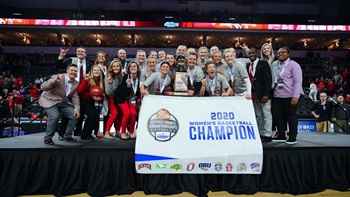USD Med School achieves one of best re accreditations in its history
“We received one of the best re-accreditation reports in our history,” said Rodney R. Parry, M.D., vice president of health affairs and dean of the medical school. “We are truly blessed with outstanding leaders and committed faculty and staff throughout the state.”
The LCME report cited nine strengths and only three relatively minor matters that are being addressed. Two transitional issues were noted. For the first time, the report did not mention any concerns about the school’s facilities.
The most serious concern in the last accreditation report was the inadequate facilities on the Vermillion campus. That issue was addressed with the state-of-the-art, $37 million Andrew E. Lee Memorial Medicine and Science Building, which was officially dedicated in the fall of 2008.
In addition to the Lee Med Building, other strengths included the medical school’s leadership, professionalism integrated fully into the curriculum, a supportive environment for medical students, dedicated doctors who teach courses throughout the state, faculty mentoring and strong hospital system partners.
The accreditation site visit team visited the medical school in October 2009. The Liaison Committee on Medical Education issued its final report last month.
Strengths identified by the Liaison Committee on Medical Education in its final report:
•Rodney Parry, M.D., dean of the Sanford School of Medicine – Parry’s credibility with the practicing physician community and the medical school’s clinical partners has been of considerable benefit to the school and its educational and research programs.
•School Leadership – In addition to Parry, many of the other medical school administrators and faculty have longstanding ties to the medical school and to the region. This stability of leadership and ties to the practice community have been of benefit to the school in developing and maintaining linkages that are vital to the educational program.
•New Leaders – New leadership positions have been created that have positively impacted the educational and research programs. A new dean of the clinical faculty is supporting faculty development for clinical faculty at all campuses. The new director of faculty mentoring is working to enhance collaboration between basic science and clinical faculty in research.
•Professionalism – The concept of professionalism has been longitudinally integrated into the curriculum. In addition, students have formal opportunities to comment on the professionalism of their peers and supervisors. The medical school has creatively used such comments by students to recognize gaps in professionalism within the learning environment and to bring about needed change.
•Supportive Environment – Medical students are appreciative of the supportive and responsive medical school environment. This is exemplified by the rapid response to student needs, including efforts to respond to their feedback on courses and clerkships.
•Impressive Facilities – There are new and impressive education and health facilities. For example, the new medical education building on the Vermillion campus is attractive and functional. Its design provides opportunities for medical students to collaborate with allied health students both in classes and in more informal settings.
•Dedicated Physicians – Physicians within the community have shown significant dedication to the medical school. Many express the desire to “give back” to the school from which they graduated. They do this in large numbers by participating in teaching and supervising medical students.
•Faculty Mentoring – Clinical department chairs are actively engaged in outreach to and mentoring of faculty at all campuses. Junior faculty commented positively on the nurturing relationships that leadership has created within departments.
•Partners – The health systems who are the clinical partners of the medical school have demonstrated their significant support for and commitment to medical education and scholarship in a number of concrete ways, including providing funding for medical student scholarships, sponsoring faculty research, and contributing to education.
Areas being addressed:
•Program Review – The survey team concluded no formal review occurs of graduate programs outside the medical school in which medical school faculty participate. A review is required. USD is expected to address this.
•Patient and Clinical Conditions – The team report stated that in some clerkships the types of patients and clinical conditions do not appear to be guided by the educational program objectives. Medical school leaders will host a discussion of how to achieve this requirement at a meeting of regional medical schools and then select a best practice to implement here.
•Student Feedback – The team report found that although students on the Yankton campus receive monthly written formative feedback it is not structured to provide students with sufficient information regarding their progress in meeting the final performance and evaluation criteria. The grading process is already being made clearer to students on the Yankton campus.
Transitional issues:
•State Deficit – The survey team notes that the impact of the state budget deficit on medical school funding will not be known until the end of the legislative session.
•Match, Test Scores – Recent improvements in match statistics and USLME test scores need to be monitored, which the medical school is already doing.


